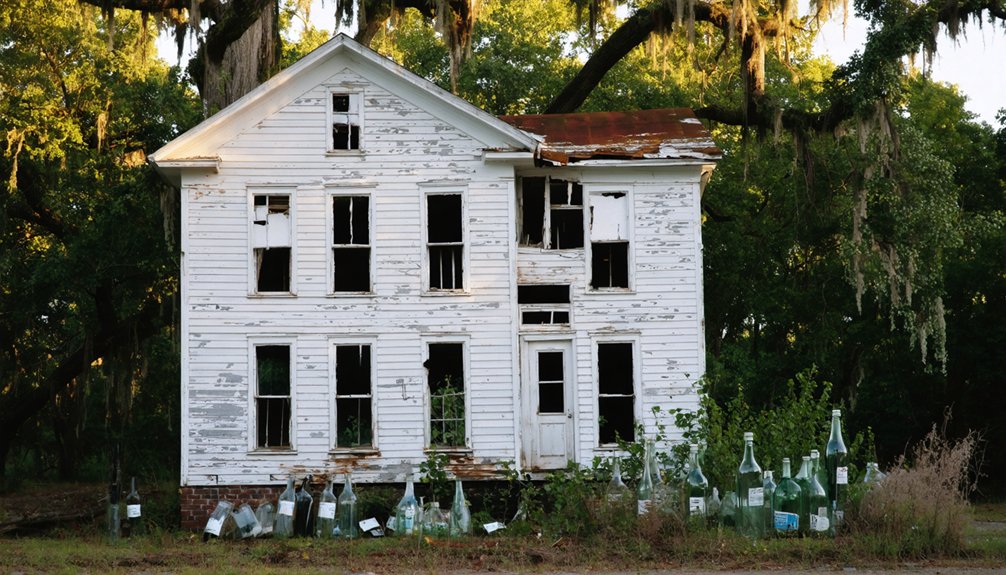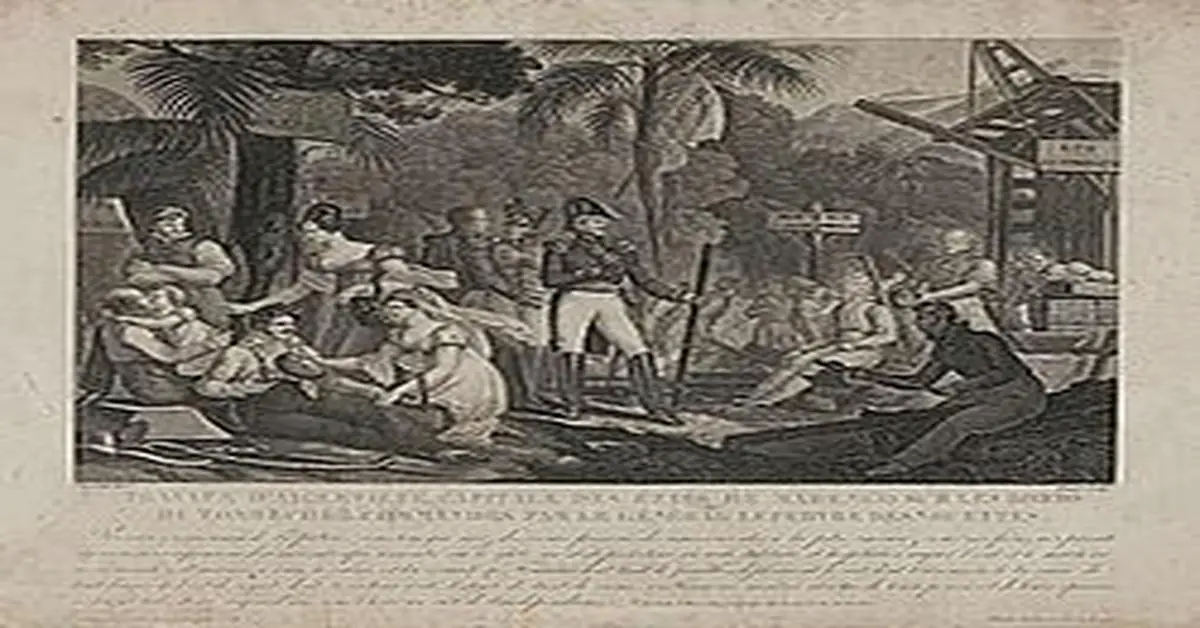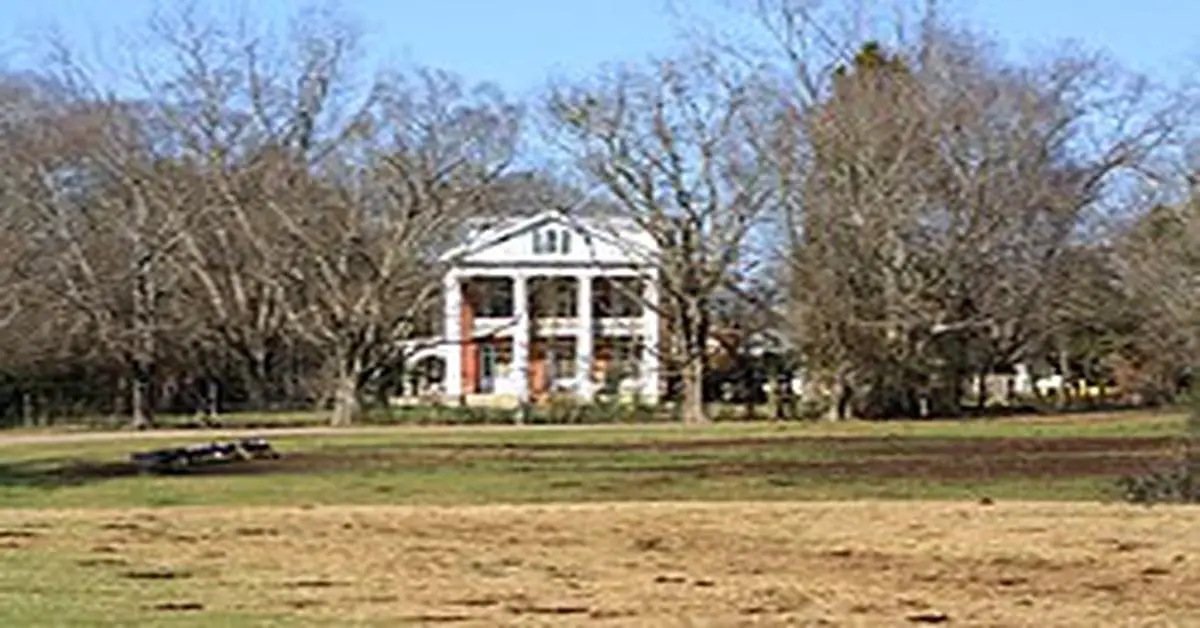You’ll find Old Ramer about 24 miles from Montgomery, Alabama, where it once thrived as an agricultural hub with a sugar mill, general store, and hotel. Originally called Athens, this ghost town‘s decline began when major railroads bypassed it in the 1880s. Today, you can spot impressive remnants like an 1800-era home and a 1908 house still standing among ruins, while scattered artifacts hint at countless untold stories from this lost community’s past.
Key Takeaways
- Old Ramer transformed from a thriving agricultural hub into a ghost town after being bypassed by major railroad routes in the 1880s.
- The town’s decline accelerated after its sugar mill closed in 1895, triggering subsequent business closures and population loss.
- Historic structures remain, including an 1800s-era home and 1908 house, alongside ruins and artifacts from the town’s prosperous past.
- Transportation isolation severely impacted Old Ramer when new highways bypassed the area, leading to economic deterioration and community exodus.
- Originally named Athens, the town served as a vital agricultural shipping point before modern transit routes redirected commerce elsewhere.
The Early Days of Old Ramer
While many early Alabama settlements underwent name changes, Old Ramer‘s story began as Athens before adopting its distinctive creek-inspired name in 1851.
You’ll find this settlement’s roots firmly planted in Montgomery County, about 24 miles from the city of Montgomery, where early pioneers established themselves at an elevation of 469 feet. Like many locations, Old Ramer required proper disambiguation links to distinguish it from other places sharing the name.
The community’s identity quickly took shape as settlement patterns emerged around essential services. Much like Capps Alabama, the town served as an important shipping point for local agricultural products.
You’d have found a bustling sugar mill, reflecting the area’s agricultural foundation, alongside a general store that served as the heart of daily commerce. A hotel welcomed travelers passing through, while the blacksmith’s hammer rang out across the town, keeping the community’s tools and equipment in working order.
This combination of services created a self-sustaining hub for local residents.
Life in a Rural Alabama Community
You’d find families in Old Ramer rising before dawn to tend their crops and livestock, with daily tasks revolving around the rhythms of planting, harvesting, and animal care.
Local folks would gather regularly at the feed store and general mercantile, trading goods and sharing news while strengthening the bonds that kept their rural community tight-knit. The town’s consistently poor accessibility scores meant residents relied heavily on these centralized gathering spots. The new Rural Roadmap Initiative aims to address these longstanding infrastructure challenges facing small Alabama towns.
Your success in this farming town depended heavily on informal networks of neighbors who’d swap labor during busy seasons, share equipment, and support each other through the challenges of agricultural life.
Daily Agricultural Routines
During the early twentieth century, life in rural Ramer revolved around a sun-up to sundown schedule of agricultural tasks that defined the community’s daily rhythm.
You’d start your morning tending to livestock, feeding chickens and cattle before moving on to field work. The introduction of crop rotation meant you’d work different fields throughout the seasons, planting cotton alongside subsistence crops like corn and peas. The boll weevil infestation in 1910 forced many local farmers to diversify their crops beyond cotton. A reliance on traditional slash-and-burn methods meant farmers had limited options when seeking new land to cultivate.
Your daily routine would include watering and feeding the animals, moving herds between pastures, and managing the various forage grasses that sustained them.
In the fields, you’d spend hours on tasks like soil preparation, planting, and weeding. When cotton picking season arrived in late summer, you’d join family members and hired hands in the labor-intensive harvest that lasted well into fall.
Community Gatherings and Events
Beyond the daily field work and farm chores, Ramer’s social fabric came alive through regular community gatherings that brought together both human and supernatural residents. You’d find the churches and schoolhouses packed whenever preachers visited, with horses tied to mounting blocks outside while folks worshipped and socialized inside.
Community bonding flourished through seasonal festivities that marked planting and harvest times. Like the Three Sisters method practiced by Indigenous peoples, the community’s farming traditions centered around cooperative planting approaches. Young couples courted on horseback, while children danced and played during summer breaks.
The arrival of rolling stores brought extra excitement, offering treats and essential goods through bartering. Ramer’s unique governance structure – a coalition of witches, werewolves, and founding families – maintained order at these gatherings, ensuring peaceful coexistence between all residents while preserving the town’s independent spirit.
Local Trade Networks
Life in Ramer revolved around a complex web of trade networks that kept the rural community connected and supplied. You’d find local farmers bringing their cotton harvests to merchants who’d store it until it could be shipped to larger markets.
Rolling stores were a lifeline for isolated families, bringing essential goods right to your doorstep and accepting farm products as payment. Local mills utilized northern investment capital to establish and expand their operations.
Trade partnerships formed between farmers and merchants weren’t just business dealings – they were crucial relationships that helped the community thrive. Livestock markets emerged as vital trading hubs for local cattlemen. You could spot wagons loaded with cotton heading to the railroad depot, while riverboats along the Alabama River carried goods to and from Montgomery.
Despite poor road conditions and limited infrastructure, these trade networks helped Ramer’s residents maintain their independence and sustain their way of life.
Transportation’s Role in Growth and Decline
You’ll find Old Ramer’s early success was tied to its position within the traditional transportation routes, including Native American trails that evolved into local roads.
The town’s isolation began when major railroad routes bypassed the area, leaving it disconnected from the bustling trade networks that fueled growth in neighboring communities. Modern surveys and explorations have helped historians accurately document the abandoned properties and transportation infrastructure that once made Old Ramer a thriving hub.
You can trace the final blow to Old Ramer’s significance when modern highway systems redirected traffic away from the town, effectively cutting off the remaining lifelines of commerce and travel that had sustained the community.
Early Railroad Connections
When the South & North Alabama Railroad arrived in the 1880s, it transformed the economic landscape of central Alabama by connecting Montgomery to Decatur through Jones Valley.
You’d have seen how railroad expansion shaped the fate of towns like Ramer, as communities without rail connections often withered while those along the tracks flourished.
The Louisville & Nashville Railroad‘s takeover in 1871 proved essential, injecting much-needed capital after earlier financial struggles had halted construction.
While smaller lines like the Union Springs & Northern helped connect rural areas to major routes, you’ll find that a town’s survival often depended on maintaining these important rail links.
The economic impact was clear – those communities that secured and kept their railroad connections typically prospered, while others faded into obscurity.
Highway System Changes
Just as railroads shaped Alabama’s early development, the state’s evolving highway system brought another wave of transformation to communities like Ramer.
You’ll find that this small town’s highway history mirrors the broader changes that swept across Alabama when the State Highway Department began coordinating road development in 1911.
As U.S. Route development progressed through the 20th century, you could see the infrastructure evolution taking its toll on Ramer’s significance.
When newer highways began bypassing smaller communities to improve efficiency, towns like Ramer faced growing isolation.
While these road improvements brought prosperity to some areas, they left others behind.
What was once a thriving community connected by dirt roads and railway lines now found itself off the beaten path of Alabama’s modernized transportation network.
Modern Transit Isolation
Despite its historical significance as a rail-connected community, Ramer now stands as a stark example of modern transit isolation in Alabama.
You’ll find that like many rural towns that once thrived along railroad routes, Ramer’s disconnection from major transit networks has contributed to its decline. When railroads diminished and automobiles took over, communities like Ramer faced increasing transit challenges.
Today, you’re looking at a town that exemplifies rural accessibility issues common throughout Alabama.
Without regular bus service or passenger rail connections, residents must rely heavily on personal vehicles. This isolation reflects a broader pattern you’ll see across the state, where the shift from rail-based transportation to highways has left many historic communities struggling to maintain their economic importance in an increasingly connected world.
Economic Changes and Population Shifts
As the nineteenth century drew to a close, Old Ramer’s economic fortunes took a dramatic turn with the closure of its sugar mill in 1895. The mill’s shutdown marked the end of the town’s economic resilience, triggering a cascade of business closures including the hotel, general store, and blacksmith shop that had once served the thriving community.
You’ll find that demographic trends followed a predictable pattern: as jobs disappeared, residents sought opportunities elsewhere, primarily in growing urban centers with more diverse economies.
The exodus intensified as new transportation routes bypassed the town, further isolating it from regional commerce. What was once a bustling hub along the stagecoach route became a stark reminder of how quickly a community’s fortunes can change when its economic foundation crumbles.
Physical Remnants and Lost Structures

Today’s visitors to Old Ramer will find a mix of enduring structures and ghostly traces that tell the story of its past glory.
You’ll discover an impressive 1800-era home standing proudly alongside a still-inhabited 1908 house, both surviving witnesses to the town’s vibrant past.
As you explore, you’ll encounter remnant structures like foundational ruins of the old hotel and sugar mill, evidence of lost industries that once drove the local economy.
Throughout the site, you’ll spot fascinating artifacts scattered about – old moonshine containers, coins, and blacksmith shop hinges that paint a picture of daily life in this former bustling community.
While the general store, hotel, and other commercial buildings have largely vanished, their memory lives on through these physical traces that dot the privately-owned landscape.
Historical Significance in Madison County
When settlers first established Old Ramer, originally known as “Boiling Springs,” they became part of Madison County‘s rich pioneering legacy.
You’ll find their story intertwined with the county’s foundation in 1808, named after President James Madison, during Alabama’s territorial period.
Old Ramer’s historical landmarks reflect the area’s significant military heritage, particularly during the Civil War when Confederate and Union forces clashed nearby.
The region’s cultural heritage runs deep through education, exemplified by institutions like Green Academy, one of Alabama’s oldest schools.
You’ll discover that Old Ramer’s early families contributed to Madison County’s broader impact on Alabama’s development, joining other pioneering settlers who shaped the Tennessee Valley‘s political and economic growth.
Their influence continues through preserved sites and commemorative markers throughout the county.
Frequently Asked Questions
Are There Any Paranormal Stories or Legends Associated With Old Ramer?
Like a closed book waiting to be read, you won’t find documented ghost sightings or haunted locations in Old Ramer’s history. No significant paranormal stories have survived through local folklore.
What Native Tribes Originally Inhabited the Old Ramer Area?
You’ll find the Creek (Muscogee) were the primary Native American inhabitants of your area, though Cherokee influences extended south, and both tribes left their mark on the region’s rich tribal history.
Did Any Notable Crimes or Murders Occur in Old Ramer?
You won’t find any unsolved mysteries in Old Ramer’s Instagram feed – or anywhere else. Historical records don’t show any notable crimes or murders in this town’s documented crime history.
Can Visitors Legally Explore the Old Ramer Site Today?
You’ll need to check local ghost town regulations and obtain exploration permits, as most of the land is privately owned. Contact Montgomery County officials before visiting to guarantee legal access.
What Was the Maximum Recorded Population of Old Ramer?
You won’t find a maximum recorded population for this historically significant site, as no official census records tracked Old Ramer’s numbers before its population decline, though estimates suggest it remained a small rural community.
References
- https://digitalalabama.com/topic/old-ramer-alabama
- https://en.wikipedia.org/wiki/List_of_ghost_towns_in_Alabama
- https://digitalalabama.com/alabama-ghost-towns/alabama-ghost-towns/9449
- https://ahc.alabama.gov/properties/cahawba/cahawba.aspx
- https://www.youtube.com/watch?v=d-Tuy6jw6TQ
- https://freepages.history.rootsweb.com/~gtusa/usa/al.htm
- https://en.wikipedia.org/wiki/Ramer
- https://www.homestratosphere.com/worst-hip-trendy-towns-in-alabama-2025/
- https://www.cullmantribune.com/2025/06/17/alabama-rural-roadmap-gudger-outlines-vision-for-rural-development/
- https://worldpopulationreview.com/states/alabama


